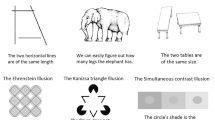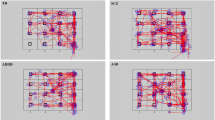Abstract
Visual and auditory verbal learning using a selective reminding format was studied in a mixed clinical sample of children with autism spectrum disorder (ASD) (n = 42), attention-deficit hyperactivity disorder (n = 83), velocardiofacial syndrome (n = 17) and neurotypicals (n = 38) using the Test of Memory and Learning to (1) more thoroughly characterize and examine the integrity of learning and memory processes, (2) to better understand the mechanisms of learning impairment, and (3) to inform instructional practices in ASD. Contrary to expectations, children with ASD demonstrated a relative weakness in the rate of acquisition of visual in contrast to verbal learning compared to neurotypicals. They also showed a complex pattern of consolidation. Overall, between-group differences were more likely to emerge during the visual learning task, suggesting that it may be more sensitive for detecting neurodevelopmental differences. The heuristic value of assessing memory and learning across multiple trials and comparing performance during immediate and delayed recall is discussed.




Similar content being viewed by others
References
Althaus, M., de Sonneville, L. M., & Minderaa, R. B. (1996). Information processing and aspects of visual attention in children with the DSM-III-R diagnosis pervasive developmental disorder not otherwise specified (PDDNOS). Child Neuropsychology, 2, 17–29.
Ambery, F. Z., Russel, A. J., Perry, K., Morris, R., & Murphy, D. G. M. (2006). Neuropsychological functioning in adults with Asperger syndrome. Autism, 10, 551–564.
American Psychiatric Association. (2000). Diagnostic and statistical manual of mental disorders (4th ed., Text Revision). Washington, DC: Author.
Autism and Developmental Disabilities Monitoring Network Surveillance Year 2002 Principal Investigators; Centers of Disease Control and Prevention. (2007). Prevalence of autism spectrum disorders—autism and developmental disabilities monitoring network, 14 sites, United States, 2002. MMWR Surveillance Summary, 9, 56, 12–28.
Baguley, T. (2009). Standardized or simple effect size: What should be reported? British Journal of Psychology, 100, 603–617.
Barnes, A. B., Howard, J. H., Howard, D. V., Gilotty, L., Kenworthy, L., Gaillard, W. D., et al. (2010). Intact implicit learning of spatial context and temporal sequences in childhood autism spectrum disorder. Neuropsychology, 22, 563–570.
Baron-Cohen, S., Lombardo, M. V., Auyeung, B., Ashwin, E., Chakrabarti, B., & Knickmeyer, R. (2011). Why are autism spectrum conditions more prevalent in males? PLoS Biology, 9(6), e1001081.
Barth, C., Fein, D., & Waterhouse, L. (1995). Delayed match to sample performance in autistic children.Developmental Neuropsychology, 11 (1), 53–69. doi:10.1080/87565649509540603.
Belia, S., Fidler, F., Williams, J., & Cumming, G. (2005). Researchers misunderstand confidence intervals and standard error bars. Psychological Methods, 10, 389–396.
Bennetto, L., Pennington, B. F., & Rogers, S. J. (1996). Intact and impaired memory functions in autism. Child Development, 67(4), 1816–1835.
Dennis, M., Francis, D. J., Cirino, P. T., Schachar, R., Barnes, M. A., & Fletcher, J. M. (2009). Why IQ is not a covariate in cognitive studies of neurodevelopmental disorders. Journal of the Neuropsychological Society, 15, 331–343.
Fein, D., Dunn, J., Allen, D. A., Aram, D. M., Hall, N., Morris, R., et al. (1996). Language and neuropsychological findings. In I. Rapin & L. Wing (Eds.), Preschool children with inadequate communication: Developmental language disorder, autism, low IQ (pp. 123–154). London: MacKeith. (Clinics in Developmental Medicine, No. 139).
Feingold, A. (2009). Effect sizes for growth-modeling analysis for controlled clinical trials in the same metric as for classical analysis. Psychological Methods, 14, 43–53.
Fombonne, E. (2005). The changing epidemiology of autism. Journal of Applied Research in Intellectual Disabilities, 8, 281–294.
Goddard, L., Howlin, P., Dritschel, B., & Patel, T. (2007). Autobiographical memory and social problem-solving in Asperger syndrome. Journal of Autism and Developmental Disorders, 37(2), 291–300.
Hou, J. W., Wang, J. K., Tsai, W. Y., Chou, C. C., & Wang, T. R. (1997). CATCH 22: Deletion of locus 22q11 in velocardiofacial syndrome, DiGeorge anomaly, and nonsyndromic conotruncal defects. Journal of Formos Medical Association, 96, 419–423.
Lajiness-O’Neill, R. R., Beaulieu, I., Asamoah, A., Titus, J. B., Bawle, E. V., Ahmed, S., et al. (2006). The neuropsychological phenotype of velocardiofacial syndrome (VCFS): Relationship to psychopathology. Child Neuropsychology, 21, 175–184.
Lajiness-O’Neill, R. R., Beaulieu, I., Titus, J. B., Asamoah, A., Bigler, E., Bawie, E. V., et al. (2005). Memory and learning in children with 22q11.2 deletion syndrome: Evidence for ventral and dorsal stream disruption? Child Neuropsychology, 11, 55–71.
Lieberman, M. D. (2000). Intuition: A social cognition neuroscience approach. Psychological Bulletin, 126, 109–137.
Littell, R. C., Milliken, G. A., Stroup, W. W., Wolfinger, R. D., & Schabenberger, O. (2006). SAS for mixed models (2nd ed.). Cary, NC: SAS Institute Inc.
Lord, C., Risi, S., Lambrecht, L. H., Leventhal, B. L., DiLavore, P. C., Pickles, A., et al. (2000). The autism diagnostic observation schedule-generic: A standard measure of social and communication deficits associated with the spectrum of autism. Journal of Autism and Developmental Disorders, 30, 205–223.
Lord, C., Rutter, M., & Le Couteur, A. (1994). Autism diagnostic interview-revised: A revised version of a diagnostic interview for caregivers of individuals with possible pervasive developmental disorders. Journal of Autism and Developmental Disorders, 24, 659–685.
Lovaas, O. I. (1987). Behavioral treatment and normal educational and intellectual functioning in young autistic children. Journal of Consulting and Clinical Psychology, 55, 3–9.
McPartland, J. C., Webb, S. J., Keehn, B., & Dawson, G. (2011). Patterns of visual attention to faces and objects in autism spectrum disorder. Journal of Autism and Developmental Disorders, 41, 148–157.
Minshew, N. J., & Goldstein, G. (1993). Is autism an amnesic disorder? Evidence from the California Verbal Learning Test. Neuropsychology, 7, 209–216.
Minshew, N. J., & Goldstein, G. (1998). Autism as a disorder of complex information processing. Mental Retardation and Developmental Disabilities Research Reviews, 4, 129–136.
Minshew, N. J., & Goldstein, G. (2001). The pattern of intact and impaired memory function in autism. Journal of Child Psychology and Psychiatry, 42, 1095–1101.
Minshew, N. J., Goldstein, G., Muenz, L. R., & Payton, J. B. (1992). Neuropsychological functioning in nonmentally retarded autistic individuals. Journal of Clinical and Experimental Neuropsychology, 14(5), 749–61.
Morris, S. B., & DeShon, R. P. (2002). Combining effect size estimates in meta-analysis with repeated measures and independent-groups designs. Psychological Methods, 7, 105–125.
Mottron, L., Burack, J., & Stauder, J. (1999). Perceptual processing among high-functioning persons with autism. Journal of Child Psychology and Psychiatry, 40, 203–211.
Renner, P., Klinger, L. G., & Klinger, R. K. (2000). Implicit and explicit memory in autism: Is autism an amnesic disorder? Journal of Autism and Developmental Disorder, 30, 3–14.
Reynolds, C. R., & Bigler, E. D. (1994). Test of memory and learning. Examiner’s manual. Austin, TX: Pro-Ed.
Russell, J., Jarrold, C., & Henry, L. (1996). Working memory in children with autism and with moderate learning difficulties. Journal of Child Psychology and Psychiatry, 37(6), 673–686.
SAS Institute Inc. (2009). SAS/STAT 9.2 user’s guide (2nd ed.) Cary, NC: SAS® Institute Inc.
Shah, A., & Frith, U. (1993). Why do autistic individuals show superior performance on the block design task? Journal of Child Psychology and Psychiatry, 34, 1351–1364.
Smith, T., Groen, A. D., & Wynn, J. W. (2000). Randomized trial of intensive early intervention for children with pervasive developmental disorder. American Journal of Mental Retardation, 105, 269–285.
Toichi, M., & Kamio, Y. (2002). Long-term memory and levels-of-processing in autism. Neuropsychologia, 40, 964–969.
Wechsler, D. (1991). Wechsler Intelligence Scale for children (3rd ed.). San Antonio, TX: Pearson.
Wechsler, D. (1999). Wechsler abbreviated scale of intelligence. San Antonio, TX: Pearson.
Wechsler, D. (2003). Wechsler Intelligence Scale for Children – Fourth Edition. San Antonio, TX: Pearson.
Westfall, P., Tobias, R., & Wolfinger, R. (2011). Multiple Comparisons and Multiple Tests Using SAS (2nd ed.). Cary, NC: SAS® Institute Inc.
Wilkinson, D. A., Best, C. A., Minshew, N. J., & Strauss, M. S. (2010). Memory awareness for faces in individuals with autism. Journal of Autism and Developmental Disorders, 40, 1371–1377.
Williams, D. L., Goldstein, G., & Minshew, M. J. (2005). Impaired memory for faces and social scenes in autism: Clinical implications of memory dysfunction. Archives of Clinical Neuropsychology, 20, 1–15.
Williams, D. L., Goldstein, G., & Minshew, M. J. (2006). The profile of memory function in children with autism. Neuropsychology, 20, 21–29.
Zinke, K., Fries, E., Altgassen, M., Kirschbaum, C., Dettenborn, L., & Kliegel, M. (2010). Visuospatial short-term memory explains deficits in tower task planning in high-functioning children with autism spectrum disorder. Child Neuropsychology, 16, 229–241.
Author information
Authors and Affiliations
Corresponding author
Rights and permissions
About this article
Cite this article
Erdődi, L., Lajiness-O’Neill, R. & Schmitt, T.A. Learning Curve Analyses in Neurodevelopmental Disorders: Are Children with Autism Spectrum Disorder Truly Visual Learners?. J Autism Dev Disord 43, 880–890 (2013). https://doi.org/10.1007/s10803-012-1630-9
Published:
Issue Date:
DOI: https://doi.org/10.1007/s10803-012-1630-9




